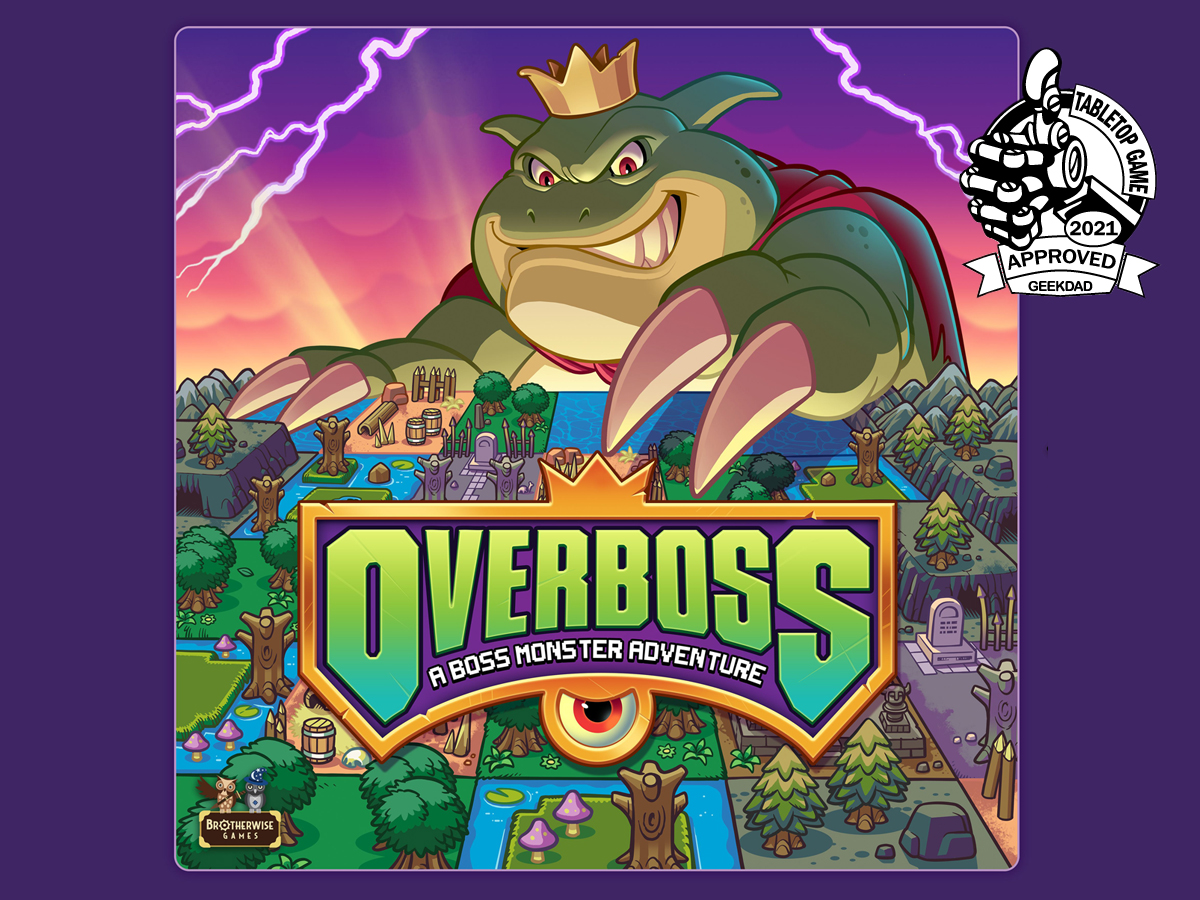Boss Monsters, time to exit your dungeons! Create your overworlds, assembling terrain and populating it with monsters to defeat those pesky adventurers.
In Reaping the Rewards, I take a look at the finished product from a crowdfunding campaign. Overboss was initially funded through Kickstarter in July 2020, and was shipped to backers in March 2021. It’s now available in stores. This review is adapted from my initial Kickstarter Tabletop Alert—there were several changes made as a result of the successful campaign. (Note: the game was originally launched as Overlord, but was renamed Overboss because of some trademark issues.)
What Is Overboss?
Overboss is a tile-placement game for 1 to 5 players, ages 8 and up, and takes about 20 to 30 minutes to play. It retails for $44.95 and is available directly from Brotherwise Games and in stores. The rules are easy enough for kids, though they may need some help with the math for scoring depending on skill level. The game shares a family-friendly theme and setting with Boss Monster, but is a stand-alone game with completely different gameplay.
Overboss was designed by Aaron Mesburne (a first-time designer) and Kevin Russ (designer of Calico) and published by Brotherwise Games, with illustrations by Darren Calvert (artist of Boss Monster).

Overboss Components
Because of stretch goals reached during the Kickstarter campaign, Overboss ended up with a lot more than I had in my original review, including both a 5th player board and solo rules, a lot more terrain types, and some boss cards and command cards.
Here’s what comes in the box:
- 5 Player boards
- 120 Terrain tiles (12 tiles each in 10 types)
- 8 Dungeon tiles
- 100 Monster tokens (10 tokens each in 10 types)
- 10 Crystal tokens
- 7 Portal tokens
- 6 Miniboss tokens
- Token bag
- 10 Terrain Selection cards
- 18 Command cards
- 10 Boss cards
- Score pad

The player boards are double-sided, with a 3×4 grid on one side and a 4×4 grid on the other, allowing for a shorter game and a longer game. The board itself isn’t that exciting, but it does have some fun details in it: it looks like a large plot of dirt, with a few scattered plants and some bones, all done in a pixel art style. The edges include some water and mountain areas. The 3×4 side does have a little more decoration at the bottom, including a lair that looks like some stone ruins and a dungeon entrance.

The tiles represent various types of terrain: forests, swamps, caves, and so on. There are several versions of each terrain type so you get a bit of variety even within a terrain type, and there are some fun little details hidden throughout. (One of my favorites is the orc camp whose flag is a campfire with marshmallows on sticks; the campfire in the camp itself also includes some roasting marshmallows.) Each token also has a little icon indicating its terrain type, and a small stripe with scoring information. The half-sized terrain selection cards can be used to pick random terrain types when you play.

The tokens are monsters and a few other items, again done in the pixel art style. Each monster type and crystal matches up with a particular terrain, which you can tell by the background color, but they’re also marked with the corresponding terrain icons. If you like pixel art, you’ll enjoy the little details; if you despise pixel art, unfortunately there’s not anything else to look at in this game.
The boss cards have a larger illustration of the various bosses, which you may recognize from Boss Monster, along with some text explaining each one’s ability and scoring conditions. The boss cards are oversized cards, and mine have a bit of a bend to them—nothing too bothersome but it is noticeable. Command cards, which are small half-sized cards, have a command type at the top, a pattern that you’ll need to match, and then an effect at the bottom.
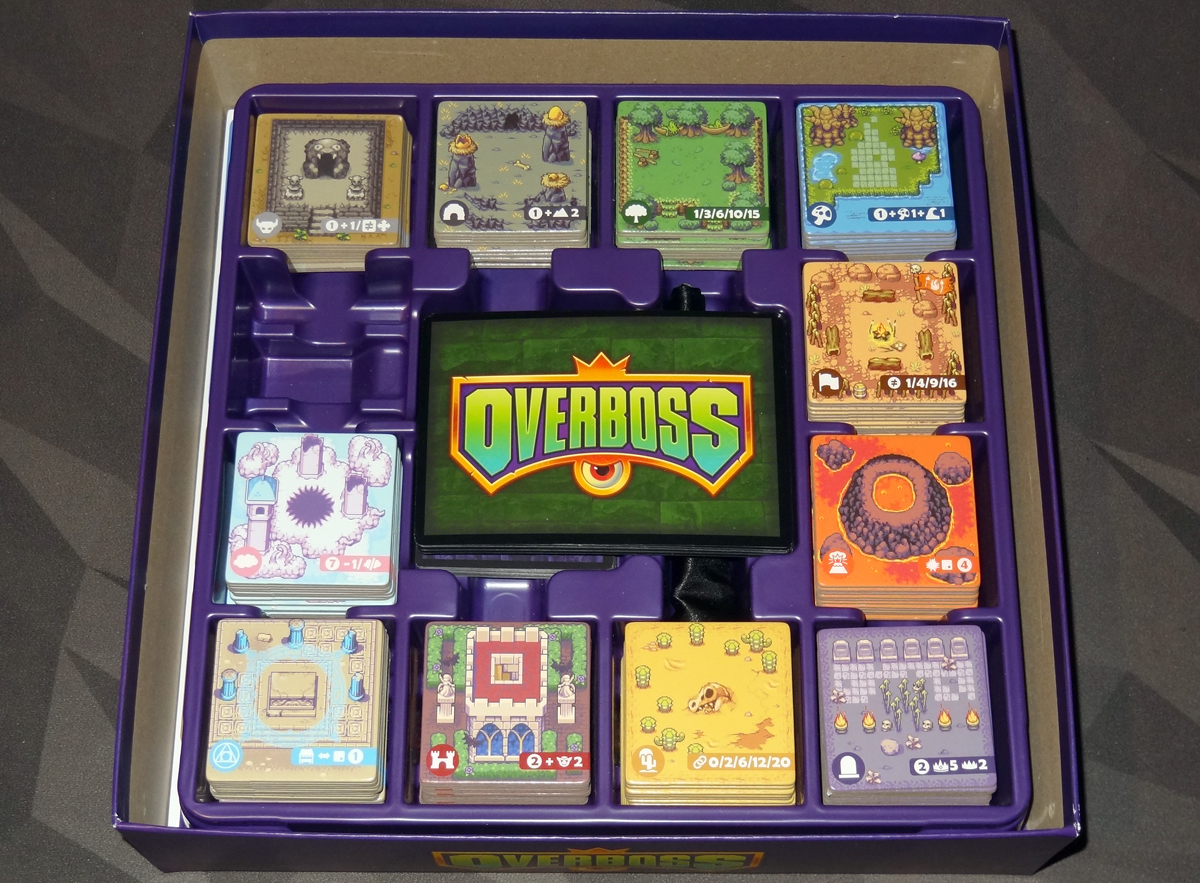
The game also comes with an excellent two-part plastic insert designed by GameTrayz. The bottom tray holds most of the components, keeping all of the various terrain tiles organized with room underneath them for the corresponding tokens. The top tray holds the boards and scorepad, plus it has room for the unassembled tile tower (sold separately). One nice touch: the scorepad pages are double-sided, so you can use the front and back of a page before recycling it.
The cloth bag is made of a satiny material, which isn’t my favorite—I prefer something a little sturdier usually—but it works okay. Overall, the components aren’t fancy, mostly square tiles, but they’re perfectly functional and they look good.
How to Play Overboss
You can download the rulebook here, as well as additional information like solo rules and a quick start guide.
The Goal
The goal of the game is to score the most points by arranging terrain tiles and monster tokens on your map.

Setup
Give each player a player board. (Everyone should use the same side, depending on whether you’re playing a short game or a longer game.)
Choose 5 terrain types you’ll use for the game, either deciding as a group or using the cards to randomize your selection. Collect all of those terrain tiles along with the corresponding monster tokens and crystal tokens. Also include the dungeon tiles, the miniboss tokens, and the portal tokens.

Shuffle the terrain tiles face-down to make a supply, and turn 4 tiles face-up to form the market. Place all the tokens in the bag, mix them up, and draw 4 tokens, placing one next to each terrain tile. The player who most recently raised a full legion of the undead is the first player.
Gameplay
On your turn, you choose a tile from the market and take the token paired with it. The terrain tile must be placed on your map—once placed, it may not be moved. Then, you place the token: monsters and minibosses must be placed on an empty terrain tile (any terrain except dungeons, which cannot hold any tokens). Crystals and portals are placed in your lair (or next to your player board if you’re using the 4×4 side). If you have a previously collected monster or miniboss in your lair, you may place it on your turn instead of the token you just collected, which then goes into your lair.
Portals are special tokens: on any turn after you collect one, you may flip it over to the “used” side to swap the location of two tokens on your map. (Or move one token from one space to another.) Note that the terrain tiles do not move, just the tokens.
At the end of your turn, draw a new terrain tile and token to refill the market.

Game End
The game ends when everyone has filled their maps. Then you score for terrains and tokens.
Each terrain type scores in a different way. I won’t list all of the terrain types, but here are the 5 recommended basic types, along with the dungeons:
- Forests: The more you have, the more points they’re worth
- Graveyards: Each graveyard has a base score; the player(s) with the most and second most score bonus points
- Orc Camps: Score points based on having different tribal flags (up to 4 flags)
- Caves: 1 point, plus 2 points if it’s next to a mountain edge
- Swamps: 1 point, plus 1 point if it’s next to water, plus 1 point if it’s next to any swamps
- Dungeons: 1 point, plus 1 point for each unique terrain type bordering it

Then you score for the tokens:
- Each monster that is on its matching terrain type scores 1 point.
- You also score for having multiples of the same monster in a row or column: 2 points for 2 monsters, 5 points for 3 monsters, and 7 points for 4 monsters.
- Each miniboss on the map scores 2 points. (Minibosses do not score bonuses for multiples.)
- Crystals (stored in your lair) award points for each terrain tile that matches the crystal.
The player with the highest total score wins! In case of a tie, the player with the highest terrain tile score wins.
Advanced Variants
There are a couple of optional things you can throw into the game.
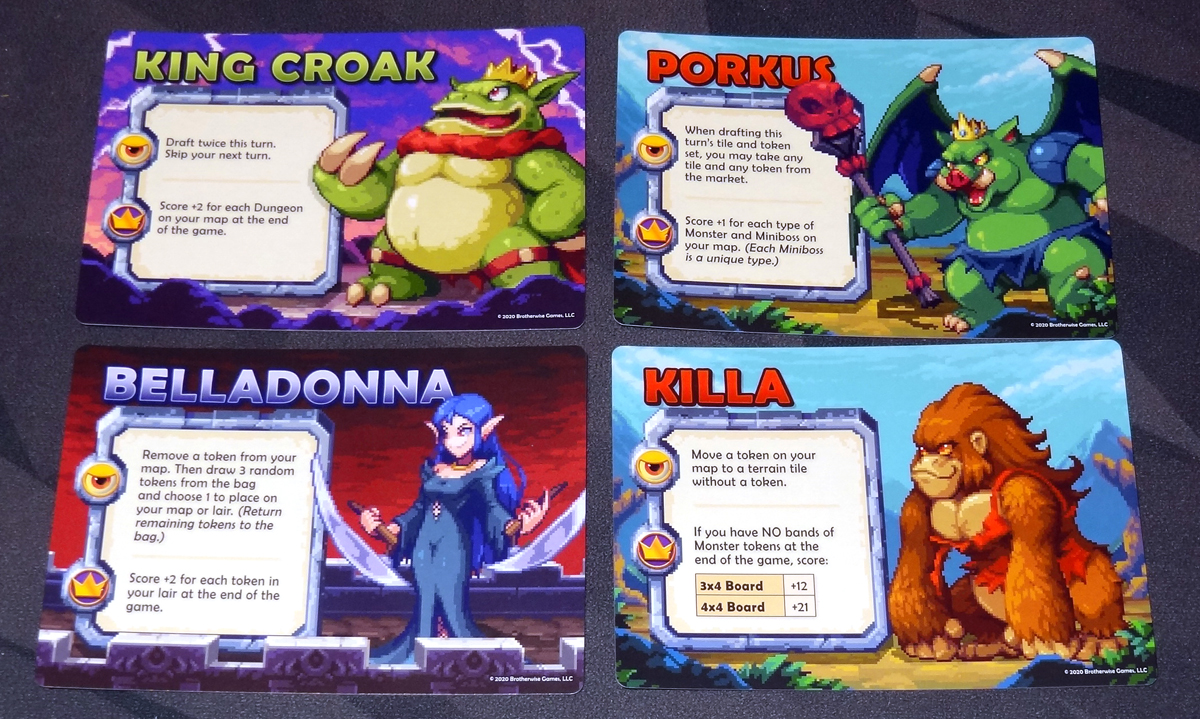
Boss Cards
Boss cards introduce a little asymmetry to the game. At the start of the game, deal 2 boss cards to each player. Everyone chooses one to keep and returns the other card to the box. Keep them secret!
Once per game, you may reveal your boss card during your turn to use its “reveal” ability.
At the end of the game, you also score bonus points according to the scoring condition on your boss card (whether you revealed it or not).

Command Cards
Command cards will let you wreak some more havoc, including messing with other people’s boards! Shuffle the command cards and deal four in a row near the tile market.
You may activate one command card per turn. To use a command card, you must make the indicated pattern in a single terrain type on your board (and it must include the tile you placed this turn). Use the card, and then discard it and replace it with another card from the deck.
There are three types of commands, which may be used on any player’s map:
- Intimidate: Slide any tile (along with its token) to an adjacent empty space.
- Demolish: Destroy any tile (and its token). The owner must immediately draft a new set from the market. (Tiles go in a discard, tokens go back into the bag.)
- Overthrow: Swap any two tiles (along with their tokens)—you can even swap tiles between two different players.
Solo Mode
There are two ways to play Overboss on your own, as explained in the solo game rules.
The High Score mode is played much like the regular game. Before you refill the market at the end of your turn, you discard the tile and token on the end of the market row, slide everything down, and refill, so it’s like a conveyor belt. Compare your score to the scoring chart to see where you fall.
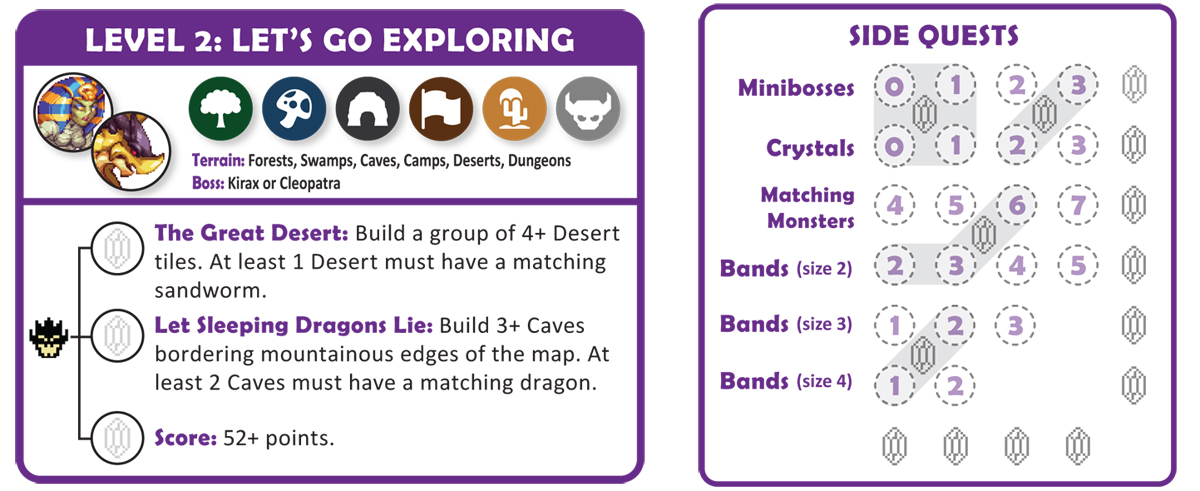
There’s also a solo campaign mode, printed on the sheet. You play through a series of 6 levels, and you have a certain number of “hearts” to complete the campaign. Each level tells you which terrain types to use and gives you 3 schemes to complete, which let you earn soul gems. You must complete at least 2 schemes before you can proceed to the next level, and each attempt uses one of your hearts. You also earn villainy icons if you get all 3 schemes in a level. There are also some side quests to complete, based on how many minibosses, crystals, matching monsters, etc. that you have at the end of a game—these can earn you additional soul gems.
At the end, you check your difficulty level, villainy icons, and soul gems to get a fun description, like “Extremely Ferocious Miniboss.”
Overboss is GeekDad Approved!
Why You Should Play Overboss
When I first reviewed Overboss last summer, we were a few months into the pandemic, and I had stopped hosting game nights at my home. I played Overboss with two of my daughters, and I also set up a camera and played with some friends over videochat (as described here). Since the game only involved a 3×4 or 4×4 grid, it was simple enough that we could get by on video, though my remote players couldn’t appreciate the pixel art, and needed to take their own notes about scoring because it was harder to see those details on-screen. Still, we managed to enjoy it, and I figured that by the time the finished game arrived, we’d be out of lockdowns and I’d get to play the game with them in person. Well, when my finished review copy arrived a few months ago, I still wasn’t ready to host in-person game nights, alas, so I’ve still been limited in my ability to share this beyond my immediate family—but I’m really looking forward to breaking it out soon, because it’s a fantastic game!
Overboss is a tile-placement game that has multiple dimensions to it. Each time you take a terrain and a token from the market, you have to consider the arrangement of your terrain and your pattern of tokens, not to mention the interactions between the two. Although the ruleset is very simple (take the tile and token and place them on your board), puzzling out the optimal spot can be a head-scratcher, and that’s what I like best about the game.

Let’s break it down a little. If the game only used terrain tiles, then you could look at the tiles available in the market and just pick the one that you had a good spot for. Maybe you’d gamble that you could get a set of different orc camps to score big, or you take the guaranteed 3 points for putting a cave in the right spot. There would even be a little bit of hate-drafting possible, as you snatch up the graveyard to prevent another player from taking the lead.
On the other hand, if you only had to worry about the tokens, then you’re just taking monsters and arranging them into rows and columns as much as possible. Easy peasy. Minibosses are worth 2 points? Better grab those when they’re available, because a miniboss by itself is worth more points than a monster.
But once you combine the two, it’s a very different picture. First, because you must place a token if you can, you’re typically placing tokens on the terrain that they’re randomly matched with in the market. That only changes when you take a dungeon (and have a leftover token) or if you take a token that doesn’t go onto the map (the portals and crystals). In those cases, you may have extra tokens that can be placed later, or you might have extra terrain tiles. Usually, though, you’re stuck with the pairings as they are in the market, so you have to make the most of them. You’re looking for a spot that will maximize the terrain score that also puts a particular monster in a band with its matching monsters. Oh, and of course, you can also gamble that you’ll be able to get a portal later to rearrange some tokens. In that case, do you place things so the monsters are lined up now to guarantee a band? Or do you place things so that if you get a portal, the monsters will be lined up at that point?
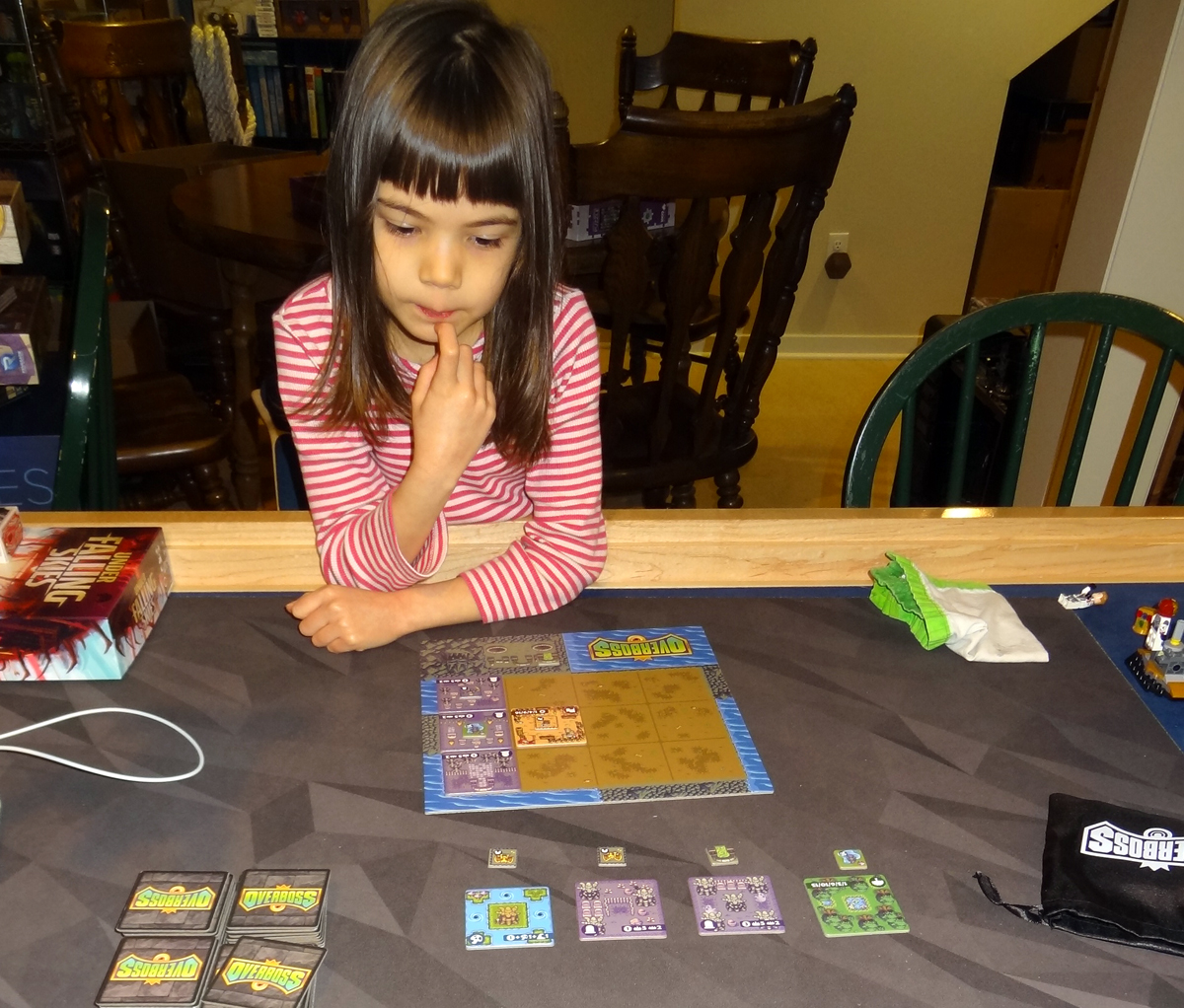
I like that the basic ruleset is easy enough that I was able to play with my 7-year-old, who really enjoyed it. Each of the terrain types is pretty easy to learn, and I was just able to tell her that monsters like being in their own terrain, but they also like being in rows and columns together. More experienced players will be able to plan a little more strategically by weighing the potential scores of different options, of course. She also liked using the boss cards, though it may take a little more experience before she learns to take the boss’ scoring bonus into account.
Now, I will mention that my teenage daughter didn’t enjoy it, because she doesn’t like building-style games in which you can’t make things perfect. Overboss is often about making the most of suboptimal choices. On some occasions, you may get exactly the terrain you were hoping for in the market, paired with the monster that matches it. But usually that’s not the case: you’ll get a great terrain but the token is all wrong, or you can pick up that portal you’ve been waiting for but you’ll get stuck with a swamp that’s almost worthless to you. If you’re hoping that your map will be exactly optimized in every direction, then you may find yourself disappointed.
Overboss uses the same theme as Boss Monster, the title that started Brotherwise Games: you are a boss monster from a video game, setting up a world that will attract (and ultimately defeat) heroes. Boss Monster was about setting up a series of rooms in a dungeon; Overboss creates a map of the surface. The artwork in this game will definitely give you some nostalgia if you grew up playing The Legend of Zelda, and it’s enough to add some thematic flavor to what would otherwise be an abstracted puzzle game.

I was already a fan of the game just based on the prototype and had been considering making it GeekDad Approved, but the finished product really seals the deal. The basic set of terrain types is enough to keep you engaged for a while, but it’s fun to have five additional types to mix in as well. For instance, volcanoes are worth 4 points, but they destroy all the monsters and minibosses next to them when you place them on your board. Deserts can score big if you have a big connected region of them. Summoning circles aren’t worth a lot of points by themselves, but they’re kind of like portals and let you swap out a token with one from the market. These new terrain types will really mix things up and challenge you to figure out the best way to arrange things on your map.
The boss cards are great for players who like a bit of asymmetry. The powers can only be used once per game, but they’re pretty fun, and you’ll want to choose the right moment to use them. The scoring bonuses vary quite a bit, and some could put you at odds with another player just depending on how things shake out.
The command cards, though, are there for players who prefer some direct player interaction. Most of Overboss is working on your individual map. Yes, there can be some hate-drafting, and there will often be some conflict with the terrain types that score based on set collection, but otherwise nobody can mess with your map… at least, until you throw in the command cards. The neat thing is that they can be equally useful on your own map as somebody else’s, helping you rearrange your map or even throwing out a tile you’ve realized doesn’t work as well. But if you like a bit of chaos, these are great for throwing wrenches in somebody else’s well-laid plans. Again—this is the sort of thing my teenage daughter would hate, but I know some friends who would revel in the ability to mess with each other’s maps.
Overboss is quick to learn, and a good fit for many GeekDad readers: it’s family-friendly, has a retro video game theme, and provides a bit of a brain-burning puzzle in a short amount of time.
For more info about Overboss, visit the Brotherwise Games website!
Click here to see all our tabletop game reviews.
![]() To subscribe to GeekDad’s tabletop gaming coverage, please copy this link and add it to your RSS reader.
To subscribe to GeekDad’s tabletop gaming coverage, please copy this link and add it to your RSS reader.
Disclosure: GeekDad received a copy of this game for review purposes.
